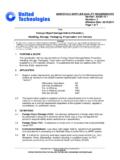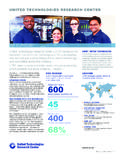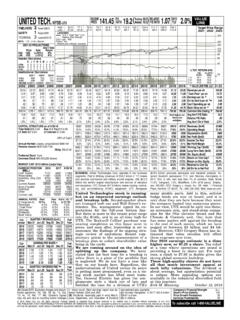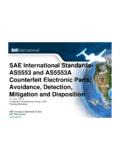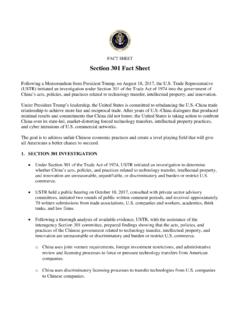Transcription of Supplier Sampling Requirements - Home | United …
1 Unpublished Work - United technologies CORPORATION 2012 This document contains no technical data subject to the EAR or the ITAR COPIES PRINTED FROM THE ON LINE SYSTEM ARE CONSIDERED UNCONTROLLED AEROSPACE Supplier QUALITY Requirements Number: Revision: 5 Effective Date: 07/10/12 Page 1 of 32 1. PURPOSE AND SCOPE This document defines Requirements for Supplier Sampling and/or distributor inspection of selected characteristics permitted by this procedure for product, material or services supplied to a Member company. 2. APPLICATION Supplier quality Requirements defined in this document are agreed upon by and applicable to the following UTC Aerospace Business Entities (also known as Members): Hamilton Sundstrand HS Pratt & Whitney PW Pratt & Whitney Canada PWC Sikorsky Aircraft SAC Note: These identifiers include all Original Equipment Manufacturing (OEM) and Aftermarket Operations (AO).
2 This specification applies to suppliers and their subcontractors who furnish product, material or services (as a manufacturer or maintenance provider) to any of the above members as a contract requirement regardless of Supplier s industry, regulatory accreditation, or certification status. 3. DEFINITIONS Acceptable Quality Level (AQL): The maximum percent defective for a vendor process that a consumer would consider to be acceptable as a process average. Usually the fraction defective at which the probability of accepting a lot is 95 percent. The AQL specifies the required sample size and an acceptance number of zero is required for samples selected from the lot. Airfoils For PWC & PW: Airfoils on integral bladed rotors, centrifugal impellers, blades and vanes. TITLE WARNING This document is the property of United technologies Corporation (UTC).
3 You may not possess, use, copy or disclose this document or any information in it, for any purpose, including without limitation to design, manufacture, or repair parts, or obtain FAA or other government approval to do so, without UTC s express written permission. Neither receipt nor possession of this document alone, from any source, constitutes such permission. Possession, use, copying or disclosure by anyone without UTC s express written permission is not authorized and may result in criminal and/or civil liability. Supplier Sampling Requirements Unpublished Work - United technologies CORPORATION 2012 This document contains no technical data subject to the EAR or the ITAR COPIES PRINTED FROM THE ON LINE SYSTEM ARE CONSIDERED UNCONTROLLED AEROSPACE Supplier QUALITY Requirements Number: Revision: 5 Effective Date: 07/10/12 Page 2 of 32 Ball Bearing Critical Characteristics For PW: Internal radial clearance, axial play, contact angle (angular contact bearings only), inner bore diameter, outer ring outer diameter, diametral cage clearance on land riding surface, end flushness, cross corner, and step height of split inner rings (where required).
4 Bearing Balls For PW: A spherical rolling element used as a component of a ball bearing assembly. Case Hardness: The surface of a part after a treatment ( , carburizing, nitriding and induction brazing). Characteristic: A property that helps to differentiate between items of a given sample or population. The differentiation may be either quantitative (by variables) or qualitative (by attributes). Continuous Process: A homogeneous process in which the product flows into the inspection station in essentially the order of manufacture and accumulation of identifiable lots may be impossible. Core Hardness: The core is the portion under the case, which is not affected by the treatment. This is the hardness of the material before the treatment, lower than the case hardness. Core hardness Requirements are specified when case hardness is also a requirement.
5 Critical Part For PWC: A selected item whose Supplementary Product Data (SPD) sheet or Supplementary Material Data (SMD) is identified with the words Critical Part , or Critical Rotating Part (Reference ). A Critical Part can also be an Engine Structural Integrity Program (ENSIP) Critical Part. In this case, the drawing will be identified with the words Critical Rotating Part or Critical Part and ENSIP Critical Part and the SPD or SMD sheet will be identified ENSIP & Critical Part Critical Characteristic: A characteristic that if nonconforming could cause an unsafe condition in the end product. (Reference ). Critical Characteristic KPC1 for PW: A part, assembly or process feature that can lead to one of the following three adverse consequences if it is not produced within prescribed limits: a. Uncontained, High Energy events b.
6 Non-recoverable operability events c. Un-commanded Engine shutdown for single engine application Defects Per Million (DPM): A metric that equals total characteristics nonconforming divided by total characteristics inspected times a million. Unpublished Work - United technologies CORPORATION 2012 This document contains no technical data subject to the EAR or the ITAR COPIES PRINTED FROM THE ON LINE SYSTEM ARE CONSIDERED UNCONTROLLED AEROSPACE Supplier QUALITY Requirements Number: Revision: 5 Effective Date: 07/10/12 Page 3 of 32 Electro-Discharge Metal Removal (EDMR) for PW: A process by which metal is removed by discharging electrical energy between the tool (electrode) and the part. Both the part and the electrode are submerged in an electrically non-conducting dielectric fluid and connected to a DC power supply. Engine Structural Integrity Part (ENSIP) Critical Part for PWC: A selected item whose drawing is identified with the words ENSIP Critical Part and the SPD or SMD sheet is identified with the words ENSIP Part (Reference ).
7 An ENSIP Critical Part can also be a Critical Part. In this case, the item s drawing will be identified with the words ENSIP Critical Part & Critical Rotating Part or Critical Part and the SPD or SMD sheet will be identified with the words ENSIP & Critical Part . Formation: The procedure of collecting, segregating or delineating production units into homogenous identifiable groups according to type, grade, class, size, composition or condition of manufacture. Hardening: Increasing hardness by suitable treatment, usually involving heating and cooling. When applicable, the following more specific terms should be used such as, annealing, precipitation heat treat or stress relief. Hardness: Resistance of material to plastic deformation or indentation, usually measured by an indentation test, such as, Rockwell, Brinell or Vickers.
8 Homogeneous Lot: A group of parts manufactured at approximately the same time that are expected to share similar quality levels for selected characteristics. These parts should come from one production run. Inspection by Attributes: Inspection whereby either the product or product characteristics are classified as conforming or nonconforming, or the number of nonconformances in the unit of product is counted, with respect to a given measurement. Inspection by Variables: Inspection wherein certain quality characteristics of samples are evaluated with respect to a continuous scale and expressed as precise points along this scale. Variable inspection records the degree of conformance or nonconformance of the unit to specified Requirements . Level Zero: Applies to Continuous Sampling Plan tables only and is the initial level required before Sampling inspection may begin.
9 Lot or Batch: A collection of units of product bearing identification and treated as a unique entity from which a sample is to be drawn and inspected to determine conformance with the acceptability criteria. Lot Diameter Variation: The difference between the average diameters of the largest and smallest balls in a finished batched lot. Unpublished Work - United technologies CORPORATION 2012 This document contains no technical data subject to the EAR or the ITAR COPIES PRINTED FROM THE ON LINE SYSTEM ARE CONSIDERED UNCONTROLLED AEROSPACE Supplier QUALITY Requirements Number: Revision: 5 Effective Date: 07/10/12 Page 4 of 32 Major Characteristic: A characteristic that if nonconforming could jeopardize the usability, proper assembly or manufacturability of the unit of product. If not within the prescribed acceptance limits, it is most likely to result in functional problems which can impair performance, where unsafe conditions for persons are unlikely.
10 Major Characteristic KPC2 for PW: A part, assembly or process feature that can lead to durability deterioration if it is not produced within prescribed limits. Major Rotating Parts For PW: Turbine and compressor hubs, shafts, disks, free turbine couplings and turbine disk side plates (full rings) that have a heat code and suffix number. Minor Characteristic: Comprise all characteristics not designated as critical or major. Minor characteristics are important for general product quality, but if nonconforming, are unlikely to result in significant impairment of performance. Mold: The body containing the cavity in which castings, composites and laminated parts are formed. Mold Control: Features of the mold that are inspected to verify acceptance of the part. Part: Any item, detail or assembly, etc., which is defined by an engineering drawing or specification.

